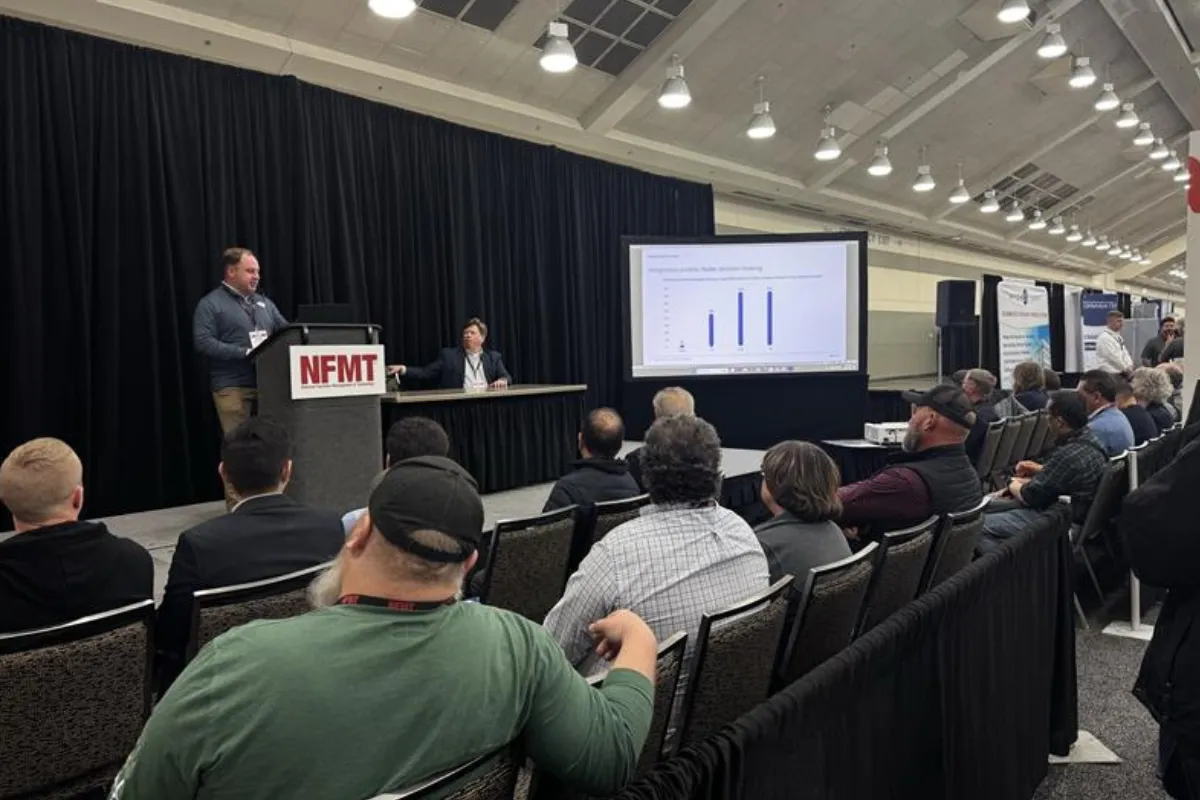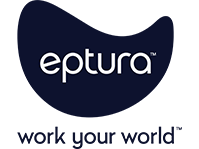
As the built environment continues to evolve, companies are looking for the right technologies and strategies to optimize space utilization and enhance the employee experience. NFMT Baltimore 2025 was an opportunity for industry leaders to share the latest trends and best practices in facility management through informative presentations and lively discussions.
With presentations, learning labs, and the largest product show floor in the country, The National Facilities Management & Technology (NFMT) event was a chance for industry professionals to engage with subject matter experts and gain practical, actionable knowledge to develop their facility management strategies. As a silver sponsor of the event, Eptura was excited to meet people from across the industry and connect with customers at our expo hall booth.
Presenting the state of the workplace and facility management industry
One of the most talked-about topics at the event, both during formal presentations by industry leaders and informal conversations between peers, was the current and coming trends in workplace and facility management.
In their presentation “2025 Asset Management Insights: Balancing Priorities, Tackling Challenges, and Embracing AI,” Mike Petrusky, director of podcasts at Eptura, and Michael Robbins, solutions engineering at Eptura, gave an overview of the key goals and challenges in asset management for the coming 24 months. Using key stats and insights from Eptura’s 2025 Workplace Index report, they covered how companies are focused on setting up centralized maintenance management, creating a fully digitalized asset inventory, and increasing the uptime of their asset portfolios.
The report lists key areas of opportunity for organizations, including:
- Leveling employee attendance more evenly throughout the week to avoid peak congestion and ensure a more consistent and comfortable workplace experience
- Analyzing and adjusting the real estate portfolio to better align with the organization’s needs can lead to significant cost savings and improved efficiency
- Implementing proactive maintenance and condition-based monitoring to extend the life span of facilities and equipment, reducing the need for frequent replacements
The presentation also outlined the challenges companies report they’re facing, including the time and resources it takes to pull and process data from separate silos. 50% of businesses use 17 standalone solutions and 37% of organizations employ 11 or more full-time employees to collate, analyze, and report on their worktech data, according to Eptura’s research.
Building a path forward
Integrating workplace and facility management into a single platform offers numerous benefits, including data-driven decision-making, enhanced management with centralized data, and improved asset uptime through early problem detection and preventive maintenance. These solutions can help organizations overcome the challenges of data fragmentation and skill gaps, leading to more effective and sustainable asset management practices. By embracing the right combination of technology and strategy, organizations can position themselves for success in a rapidly evolving landscape.
The future is more intelligent with artificial intelligence (AI)
One of the key insights from the Workplace Index report is that although many companies can clearly see the advantages of AI, they are concerned that their employees and systems are not yet ready. In fact, 50% of organizations reported insufficient skill sets and lack of cross-platform integrations as their biggest barriers to implementation.
In his second presentation, “Ushering in the New Age of FM,” Petrusky looked at how companies should see AI technology. Pulling from a diverse set of sources—including business leaders, sports celebrities, and sci-fi classics—Petrusky explained that companies need to think about organizational alignment and cybersecurity when planning an AI implementation. Ensuring that all teams are aligned and that robust risk management measures are in place is crucial for successful deployment. He also emphasized interdisciplinary learning and collaboration. When different teams work together, they can solve problems more effectively and create more value, he explained.
Change management is now a critical skill in facility management
Many of the presentations touched on the best ways to introduce people to new processes. In “Breaking the Fixed Mindset – Implementing Change from the Ground Up,” John Rimer, CFM and president at FM360 Consulting, talked about the importance of helping teams work and think in new ways. Companies need to address the challenge of “That’s How We’ve Always Done It” (THWADI)—a common barrier to organizational progress.
In facility management, examples of THWADI can include:
- Maintenance schedules: A facility manager might stick to a rigid, calendar-based maintenance schedule for all equipment, regardless of the actual condition or usage patterns, leading to unnecessary maintenance tasks, increased costs, and potential equipment failures if the schedule doesn’t align with the actual needs. A more data-driven, condition-based maintenance approach could be more efficient and effective.
- Space allocation: Office spaces are allocated based on seniority or traditional departmental structures, without considering the evolving needs of the workforce. The result is underutilized spaces, inefficient use of resources, and a mismatch between the physical environment and the work being done. A more flexible, activity-based approach to space allocation can better meet the needs of a modern, dynamic workforce.
- Technology adoption: The facility management team doesn’t want to adopt new technology like smart building systems or Internet of Things (IoT) devices, because they are comfortable with existing methods. The team misses opportunities for efficiency, cost savings, and improved occupant satisfaction. Embracing new technology can streamline operations, reduce energy consumption, and enhance the overall workplace experience.
By recognizing and addressing these THWADI mindsets, facility managers can drive meaningful change, improve operational efficiency, and create a more dynamic and responsive workplace environment.
In the session titled “How to Mitigate Risk with AI,” Dean Kashiwagi, PhD, P.E., and IFMA Fellow, talked about the critical role vendors can play in implementation. CIB W117 and Performance Based Studies Research Group (PBSRG) use the Best Value Approach (BVA) to reduce project risk. Unlike traditional methods that rely on client oversight and inspections, BVA uses vendor-led planning, early risk identification, and clear performance reporting. PBSRG has managed over 2,000 projects worth $6.7B, achieving 98% customer satisfaction, reducing vendor-caused issues to 1%, and cutting costs by 30%.
Other trending topics at NFMT Baltimore 2025
Attendees were also interested in the process of digitization and the ways they could leverage data to improve facility maintenance. They also shared a lot of interest in creating longer asset lifecycles and setting up predictive maintenance programs. Both on the stage and in the expo hall, many of the discussions about the workplace centered on finding ways to best support the in-office experience. With so many organizations reporting more people in the office more often, employee experience was top of mind for many.
Digitization
Digitization has transformed facility and maintenance management, delivering new levels of efficiency and control. IoT devices, for example, enable real-time monitoring of building systems, providing instant alerts for issues like temperature fluctuations, water leaks, or equipment malfunctions, which allows for proactive maintenance and reduces downtime. Digital twins, virtual replicas of physical assets, are becoming popular for simulating and optimizing building performance, predicting maintenance needs, and testing new systems without disruptions.
Predictive maintenance
Leveraging data from sensors and advanced analytics, teams can use predictive maintenance systems to accurately forecast equipment failures, making possible timely interventions that avoid breakdowns and reduce maintenance costs. By integrating AI and machine learning into a predictive maintenance platform, organizations can improve accuracy in finding failures before they happen. By moving away from reactive toward proactive maintenance, teams have more time and resources to focus on high-priority tasks, improving overall reliability.
Employee experience and “consistency” as a goal
Consistency in the workplace experience supports employee satisfaction, productivity, and engagement for all employees, whether they’re in the office full-time, part-time, or only occasionally. Facility managers play a pivotal role in creating consistency and should think strategically about the reasons employees come to the office, the activities they engage in, and the support they need to be effective.
In her presentation “Coffee and Culture: And Other Things That Matter in Today’s Workplace,” Alana Dunoff, MS, ProFM, FMP, and IFMA Fellow, shared research and insights from a strategic campus planning effort. She explained the variety of drivers, amenities, and occupant services that can enhance the in-person work experience, including:
- Single pod coffee machines for quick “caffeine fixes”
- Whiteboarding spaces for collaboration and creativity
- Wellness areas like quiet rooms or fitness centers for wellbeing
By finding and focusing on what matters to employees, facility managers can create a workplace that not only meets practical needs but also fosters a positive and inclusive culture.
NFMT Baltimore 2025 supports professional development
NFMT Baltimore 2025 was an opportunity for workplace and facility leaders from a wide range of industries to come together to share critical challenges and cutting-edge solutions. With presentations covering big-picture topics, including the state of facility management and change management for AI, attendees were able see the important trends shaping the industry. There were also opportunities to dive deeper into smaller, more focused areas like water plants and janitorial services so they could gain the specific knowledge and skills to succeed.
Discover more upcoming events for workplace and facility management professionals.




